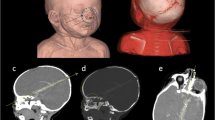Abstract
Purpose
Postmortem computed tomography angiography (PMCTA) was introduced into forensic investigations a few years ago. It provides reliable images that can be consulted at any time. Conventional autopsy remains the reference standard for defining the cause of death, but provides only limited possibility of a second examination. This study compares these two procedures and discusses findings that can be detected exclusively using each method.
Materials and methods
This retrospective study compared radiological reports from PMCTA to reports from conventional autopsy for 50 forensic autopsy cases. Reported findings from autopsy and PMCTA were extracted and compared to each other. PMCTA was performed using a modified heart–lung machine and the oily contrast agent Angiofil® (Fumedica AG, Muri, Switzerland).
Results
PMCTA and conventional autopsy would have drawn similar conclusions regarding causes of death. Nearly 60 % of all findings were visualized with both techniques. PMCTA demonstrates a higher sensitivity for identifying skeletal and vascular lesions. However, vascular occlusions due to postmortem blood clots could be falsely assumed to be vascular lesions. In contrast, conventional autopsy does not detect all bone fractures or the exact source of bleeding. Conventional autopsy provides important information about organ morphology and remains the only way to diagnose a vital vascular occlusion with certitude.
Conclusion
Overall, PMCTA and conventional autopsy provide comparable findings. However, each technique presents advantages and disadvantages for detecting specific findings. To correctly interpret findings and clearly define the indications for PMCTA, these differences must be understood.

Similar content being viewed by others
References
Dirnhofer R, Jackowski C, Vock P et al (2006) VIRTOPSY: minimally invasive, imaging-guided virtual autopsy. Radiographics 26(5):1305–1333, Review
Thali M, Dirnhofer R, Vock P (eds) (2009) The virtopsy approach: 3D optical and radiological scanning and reconstruction in forensic medicine. CRC, New York
Weustink AC, Hunink MGM, van Dijke CF et al (2009) Minimally invasive autopsy: an alternative to conventional autopsy? Radiology 250(3):897–904
Jeffery AJ (2010) The role of computed tomography in adult postmortem examinations: an overview. Diagn Histopathol 16(12):546–551
O’Donnell C (2010) An image of sudden death: utility of routine postmortem computed tomography scanning in medico-legal autopsy practice. Diagn Histopathol 16(12):552–555
Poulsen K, Simonsen J (2007) Computed tomography as a routine in connection with medico-legal autopsies. Forensic Sci Int 171(2–3):190–7
Jacobsen C, Lynnerup N (2010) Craniocerebral trauma-congruence between postmortem computed tomography diagnoses and autopsy results: a 2-year retrospective study. Forensic Sci Int 194(1–3):9–14
Roberts IS, Benamore RE, Benbow EW et al (2012) Postmortem imaging as an alternative to autopsy in the diagnosis of adult deaths: a validation study. Lancet 379(9811):136–42
Aghayev E, Sonnenschein M, Jackowski C et al (2006) Postmortem radiology of fatal hemorrhage: measurements of cross-sectional areas of major blood vessels and volumes of aorta and spleen on MDCT and volumes of heart chambers on MRI. AJR 187(1):209–215
Kennedy D, Laing C, Tseng L et al (2010) Detection of active gastrointestinal hemorrhage with CT angiography: a 4(1/2)-year retrospective review. J Vasc Interv Radiol 21(6):848–855
Karhunen PJ, Servo A (1993) Sudden fatal or non-operable bleeding from ruptured intracranial aneurysm: evaluation by post-mortem angiography with vulcanising contrast medium. Int J Legal Med 106(2):55–59
Roberts I, Benamore R, Peebles C et al (2011) Diagnosis of coronary artery disease using minimally invasive autopsy: evaluation of a novel method of post-mortem coronary CT angiography. Clin Radiol 66(7):645–650, Technical report
Saunders S, Morgan B, Raj V et al (2011) Targeted post-mortem computed tomography cardiac angiography: proof of concept. Int J Legal Med 125(4):609–616
Jackowski C, Thali M, Sonnenschein M et al (2005) Virtopsy: postmortem minimally invasive angiography using cross section techniques—implementation and preliminary results. J Forensic Sci 50(5):1175–1186
Grabherr S, Djonov V, Friess A et al (2006) Postmortem angiography after vascular perfusion with diesel oil and a lipophilic contrast agent. AJR 187(5):W515–W523
Kominato Y, Fujikura T, Hata Y et al (2006) A case of postoperative hemorrhage after a hysterectomy in which a bleeding point of the left uterine artery was identified by postmortem angiography. Legal Med 6(3):187–189
Ruder T, Ketterer T, Preiss U et al (2011) Suicidal knife wound to the heart: challenges in reconstructing wound channels with postmortem CT and CT-angiography. Legal Medicine 13(2):91–94
Grabherr S, Djonov V, Yen K et al (2007) Postmortem angiography: review of former and current methods. AJR 188(3):832–838
Saunders S, Morgan B, Raj V, Rutty G (2010) Post-mortem computed tomography angiography: past, present and future. Forensic Sci Med Pathol 7(3):271–277
Grabherr S, Gygax E, Sollberger B et al (2008) Two-step post-mortem angiography with a modified heart–lung machine: preliminary results. AJR 190(2):345–351
Grabherr S, Doenz F, Steger B et al (2011) Multi-phase post-mortem CT angiography: development of a standardized protocol. Int J Legal Med 125(6):791–802
Michaud K, Grabherr S, Doenz F, Mangin P (2012) Evaluation of postmortem MDCT and MDCT-angiography for the investigation of sudden cardiac death related to atherosclerotic coronary artery disease. Int J Cardiovasc Imaging 28(7):1807–1822
Schneider B, Chevallier C, Dominguez A (2011) The forensic radiographer: a new member in the medicolegal team. Am J Forensic Med Pathol 33(1):30–36
Brinkmann B (1999) Harmonisation of medico-legal autopsy rules. Int J Legal Med 113(1):1–14
Jackowski C, Warntjes MJ, Berge J et al (2011) Magnetic resonance imaging goes postmortem: noninvasive detection and assessment of myocardial infarction by postmortem MRI. Eur Radiol 21(1):70–8
Yen K, Thali M, Aghayev E et al (2005) Strangulation signs: initial correlation of MRI, MSCT and forensic neck findings. J Magn Reson Imaging 22(4):501–510
Bouchireb K, Teychene AM, Rigal O et al (2010) Post-mortem MRI reveals CPT2 deficiency after sudden infant death. Eur J Pediatr 169(12):1561–1563
Acknowledgments
This study was financially supported by the Promotion Agency for Innovation of the Swiss Confederation (KTI Nr.10221.1 PFIW-IW) and the Leenards Foundation, Lausanne, Switzerland.
Conflicts of interest
None
Author information
Authors and Affiliations
Corresponding author
Rights and permissions
About this article
Cite this article
Christine, C., Francesco, D., Paul, V. et al. Postmortem computed tomography angiography vs. conventional autopsy: advantages and inconveniences of each method. Int J Legal Med 127, 981–989 (2013). https://doi.org/10.1007/s00414-012-0814-3
Received:
Accepted:
Published:
Issue Date:
DOI: https://doi.org/10.1007/s00414-012-0814-3




